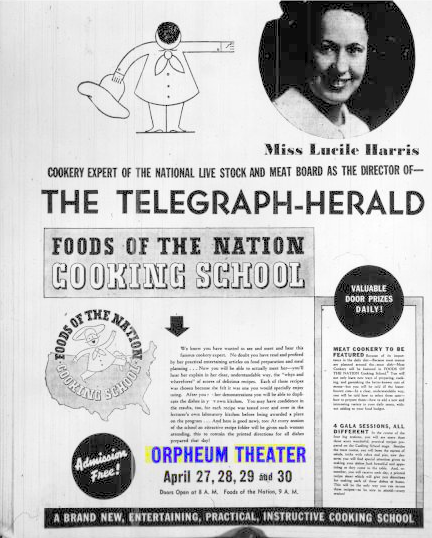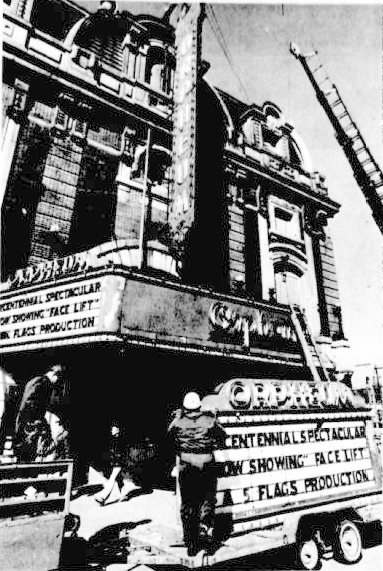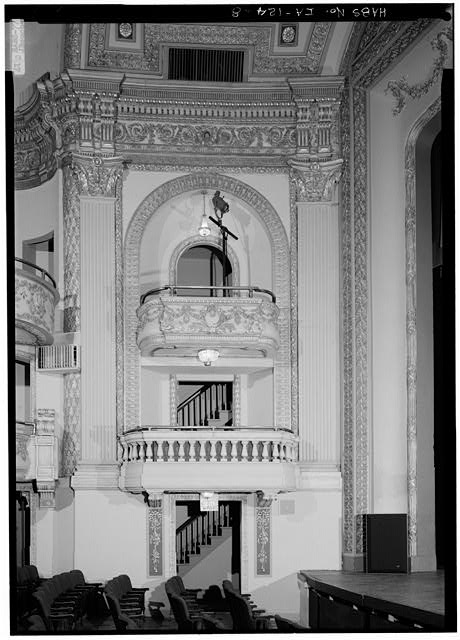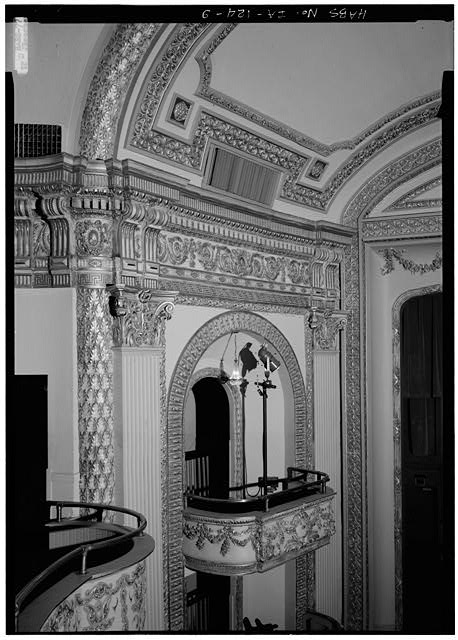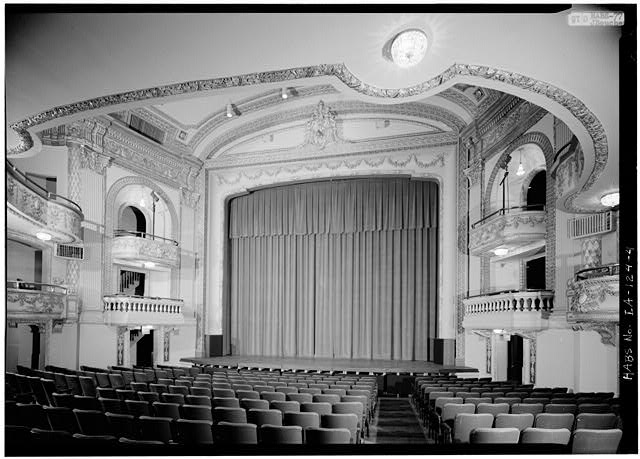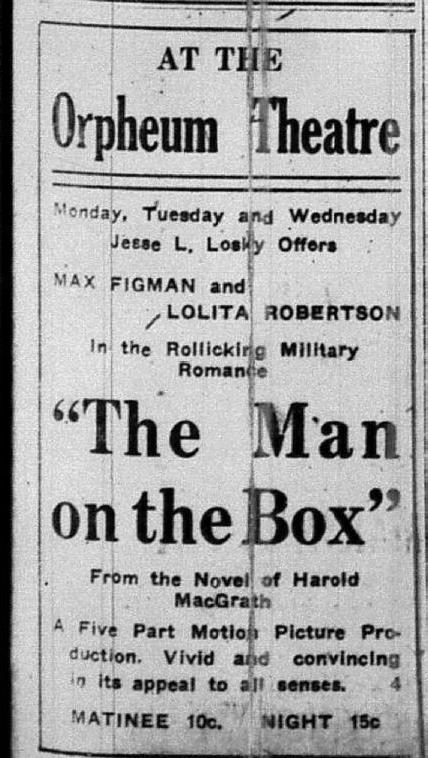Encyclopedia Dubuque
"Encyclopedia Dubuque is the online authority for all things Dubuque, written by the people who know the city best.”
Marshall Cohen—researcher and producer, CNN
Affiliated with the Local History Network of the State Historical Society of Iowa, and the Iowa Museum Association.
ORPHEUM: Difference between revisions
No edit summary |
No edit summary |
||
| (29 intermediate revisions by the same user not shown) | |||
| Line 1: | Line 1: | ||
[[Image:THEATERHISTORY.png|left|thumb|250px|Theater History. Courtesy: Telegraph Herald]]ORPHEUM THEATRE. In 1932 even as the U.S. economy foundered, RKO, an American film production and distribution company, began buying up theaters to add to its exhibition chain. RKO was formed after the Keith-Albee-Orpheum (KAO) theater chains and Joseph P. Kennedy's Film Booking Offices of America (FBO) studio were brought together under the control of the Radio Corporation of America (RCA) in October 1928. The [[SPENSLEY THEATER]], one of many purchased, became part of the RKO film theater circuit and was renamed the RKO ORPHEUM around 1934. | |||
[[ | |||
In February, 1937 the "Hawaiian Follies," a 45-minute production by native Hawaiian singers and dancers, was shown. (1) On March 16, 1937, the most popular orchestra, musical group, pianist, instrumental soloist, and singer from Tuesday night's "Radio-Stage Varieties," sponsored by the [[DUBUQUE MUSICIANS' PROTECTIVE ASSOCIATION]], were selected by theater patrons who voted for their choice in each category. Winners were featured together on the final "Varieties" show on March 23. (2) | |||
[[Image:cooking.png|left|thumb|200px|Cooking school at the Orpheum. Photo courtesy: Telegraph Herald]]In 1936 and again from April 27-30, 1937, the Orpheum became the "Telegraph-Herald Foods of the Nation Cooking School." Featuring Miss Lucille Harris, cookery expert of the National Livestock and Meat Board, the school promised live demonstrations of cooking. For every program "an attractive recipe folder" was to given each woman attending to contain the printed directions for all the dishes prepared that day. (3) At various times the newspaper hosted the cooking school at the Eagles Hall and the Cooper building at 3rd and Main. (4) Food was the price of admission at the ninth annual benefit motion picture program sponsored by the Lion's Club. Nearly anything edible allowed a child to watch two movies and cartoons. Food was distributed by case workers of the local Iowa Emergency Relief Administration. (5) | |||
Showing the tight scheduling, on the evening of the 27th was theater became a lecture hall. An estimated 300 retailers heard W. P. McDowell of Chicago speak about "Sales for a Profit" and Howard H. White of the National Live Stock and Meat Board speak about, and then demonstrate, modernization of cutting meat. (6) | |||
Together with the special programs, the showing of motion pictures remained big business. Beginning in April, 1938 double-feature entertainment was introduced. Two major features, each of single-feature rating, were offered each. The first was shown through Thursday of each week. (7) | |||
Wartime rationing led to a novel heating solution for the Orpheum in 1945. When the heating equipment of the theater failed, patrons were left a bit cold for one evening. However, the next day warmth was restored. The theater was heated from the boiler of a 1908 threshing machine transported from LaMotte and parked in the alley behind the building. The steam from the boiler, heated by burning the cheapest grades of soft coal, kept the temperature in the theater above the 68 degrees ordered by governmental bureaus. (8) | |||
The new owners, World Theater Inc. of Minneapolis, Minnesota released news of renovations scheduled for the Orpheum in 1956. An estimated $75,000 (equivalent to $689,899.25 in 2018) would be spent on relaying the auditorium floor, respacing the seating for comfort, installing a "waterfall" state curtain, repainting the auditorium walls, closing off the rear of the auditorium to reduce traffic noise with replacement of the rear lobby wall and new doors. The ceilings were to be lowered to house indirect lighting. The Rococo decoration would be updated. There would also be a new concession area and the restrooms would be redesigned for a "glamorous and beautiful effect." (9) | |||
[[File:5FLAGS.png|850px|thumb|left|An entire block was scheduled for demolition during urban renewal. Saving the Orpheum Theatre and restoring it led to converting the entire block into [[FIVE FLAGS CIVIC CENTER]]. Photo courtesy: Telegraph Herald]] | |||
[[File:apr74.png|250px|thumb|left|On April 8, 1974 exterior renovation began. Photo courtesy: Telegraph Herald]] | |||
[[Image:interior-1.jpg|left|thumb|200px|Interior view]] | |||
[[Image:interior-2.jpg|left|thumb|200px|Interior view]] | |||
[[Image:interior-3.jpg|left|thumb|200px|Interior view]] | |||
[[Image:playbill.jpg|left|thumb|150px|Photo courtesy: Telegraph Herald and Paul Hemmer]] | |||
By 1969 the Orpheum along with much of the area around Lower Main Street was suffering disastrous economic times. There was consideration for razing the theater and constructing a comparable modern replacement as part of a fifteen-block [[URBAN RENEWAL]] project. Razing the Orpheum and building a replacement theater, however, was estimated to cost between $1,250,000 and $1,500,000. Renovation of the Orpheum and building a civic center was estimated then to cost $1.3 million. Historically, the Orpheum was located where theaters had existed since the [[ATHENAEUM]] was constructed in 1840. Architectural historian Denys Peter Myers of the federal Historic Buildings Survey had written: | |||
The building has great potential as a preservable example | The building has great potential as a preservable example | ||
| Line 44: | Line 30: | ||
historic importance in connection with the proposed civic | historic importance in connection with the proposed civic | ||
center, since there is a large legitimate state and the | center, since there is a large legitimate state and the | ||
acoustics are excellent. ( | acoustics are excellent. (10) | ||
Led by such community activists as [[NORMAN, Wayne Andrew Sr.|Wayne Andrew NORMAN, Sr.]], a group developed the idea that private donations could be collected to renovate the theater into part of an exhibition-arts | Led by such community activists as [[NORMAN, Wayne Andrew Sr.|Wayne Andrew NORMAN, Sr.]], a group developed the idea that private donations could be collected to renovate the theater into part of an exhibition-arts complex. Norman was quoted as saying the project | ||
would enhance the city's architectural heritage. We | ...would enhance the city's architectural heritage. We | ||
need inner city renewal, but I fear that on a national | need inner city renewal, but I fear that on a national | ||
scale, we're developing what amounts to 'look-alike | scale, we're developing what amounts to 'look-alike | ||
cities.' ( | cities.' (11) | ||
The project was named for the five national flags that have flown over this area. Articles of incorporation for the proposed civic center stated that if the project failed, the funds collected to that point would revert to the City of Dubuque for a civic project which the council considered worthwhile. ( | The project was named [[FIVE FLAGS (name)]] for the five national flags that have flown over this area. The fundraising campaign gathered an estimated $750,000 in pledges and donations toward the civic center project. (12) Articles of incorporation for the proposed civic center stated that if the project failed, the funds collected to that point would revert to the City of Dubuque for a civic project which the council considered worthwhile. (13) | ||
Led by Norman and representatives of the [[DUBUQUE CHAMBER OF COMMERCE]], U. S. Rep. John Culver toured the Orpheum in October, 1971. By then the concept of restoring the theater and constructing a complete exhibition center adjoining it at 5th and Main had grown popular among local business | Led by Norman and representatives of the [[DUBUQUE CHAMBER OF COMMERCE]], U. S. Rep. John Culver toured the Orpheum in October, 1971. By then the concept of restoring the theater and constructing a complete exhibition center adjoining it at 5th and Main had grown popular among local business leaders and civic officials. The city council, for example, had reserved a full block of urban renewal land to encourage the project. (14) Culver pledged he would look into the possibility of federal aid. Possibilities, he believed, lay with the Department of Housing and Urban Development and the National Preservation Act. (15) | ||
In 1972 the Orpheum was added to the [[NATIONAL REGISTER OF HISTORIC PLACES]]. | |||
In 1974 the theater was owned by the city but leased to the [[DUBUQUE THEATRE CORPORATION]] to show films. On April 8, 1974 restoration on the exterior began as the start of the developing the [[FIVE FLAGS CIVIC CENTER]]. (16) | |||
On January 14, 1976 the Dubuque Recreation Commission, Five Flags Executive Committee, and the Dubuque City Council decided that an ad hoc committee should hire a full-time theater manager and operate the Orpheum until a permanent organization was established. It was also agreed that the theater should have a separate budget from the city's Recreation Commission. The theater was scheduled to be turned over to the city from the Five Flags Executive Committee on March 1st. Members of the ad hoc committee included Mayor [[LUNDH, Alvin Emil|Alvin Emil LUNDH]] and representatives of the Recreation Commission, Five Flags Executive Committee, Dubuque Chamber of Commerce, [[DUBUQUE ARTS COUNCIL]], Citizens Advisory Commission, and labor groups. It was also decided to have a cost-analysis for a second bond issue referendum to fund the construction of the center. (17) | |||
--- | |||
Source: | |||
1. "Two Added Attractions at the Orpheum This Week," ''Telegraph-Herald'', February 14, 1937, p. 15 | |||
--- | 2. "Orpheum Theater Patrons to Decide Music Contest," ''Telegraph-Herald'', March 14, 1937, p. 15 | ||
3. Advertisement. ''Telegraph-Herald'', April 21, 1937, p. 20 | |||
4. Hemmer, Paul. E-mail, January 27, 2018 | |||
5. "Food is the Price of Admission, Kids!" ''Telegraph-Herald'', November 18, 1938, p. 5 | |||
6. "Dubuqueland Retailers Hear Addresses on Merchandising," ''Telegraph-Herald'', April 27, 1937, p. 7 | |||
7. "New Double-Feature Policy is Announced by Orpheum," ''Telegraph-Herald,'' April 17, 1938, p. 19 | |||
8. "Use Thresher to Heat Show," ''Telegraph-Herald'', April 25, 1945, p. 3 | |||
9. "Plan $75,000 Redecoration of Orpheum; Respace Seats," ''The Telegraph-Herald'', September 7, 1956, p. 2 | |||
10. "Chronology Section," ''Telegraph Herald,'' December 28, 1972, p. 20 | |||
11. Brimeyer, Jack. "Dubuquers to Push Five Flags Plan Tomorrow in Washington," ''Telegraph-Herald'', February 25, 1973, p. 12 | |||
12. Hogstrom, Erik, "Orpheum Theater Restoration Work Began Creation of Five Flags Civic Center 50 Years Ago," Telegraph Herald, Apr. 25, 2024, p5A | |||
13. "5 Flags Support Sought," ''Telegraph Herald'', November 15, 1973, p. 12 | |||
14. Miller, Jim. "Five Flags Loses Shot at $1 Million," ''Telegraph Herald'', April 29, 1974, p. 1 | |||
15. "'Town Hall Meeting Planned to Discuss 5 Flags Future," ''Telegraph Herald'', December 5, 1974, p. 18 | |||
16. Miller, Jim, "Marquee Falls to Restoration," ''Telegraph Herald'', April 8, 1974, p. 4 | |||
17. "Orpheum Theatre to Open With Concert," ''Telegraph Herald'', January 15, 1976, p. 9 | |||
[[Category: Theater]] | |||
Latest revision as of 15:27, 29 April 2024
ORPHEUM THEATRE. In 1932 even as the U.S. economy foundered, RKO, an American film production and distribution company, began buying up theaters to add to its exhibition chain. RKO was formed after the Keith-Albee-Orpheum (KAO) theater chains and Joseph P. Kennedy's Film Booking Offices of America (FBO) studio were brought together under the control of the Radio Corporation of America (RCA) in October 1928. The SPENSLEY THEATER, one of many purchased, became part of the RKO film theater circuit and was renamed the RKO ORPHEUM around 1934.
In February, 1937 the "Hawaiian Follies," a 45-minute production by native Hawaiian singers and dancers, was shown. (1) On March 16, 1937, the most popular orchestra, musical group, pianist, instrumental soloist, and singer from Tuesday night's "Radio-Stage Varieties," sponsored by the DUBUQUE MUSICIANS' PROTECTIVE ASSOCIATION, were selected by theater patrons who voted for their choice in each category. Winners were featured together on the final "Varieties" show on March 23. (2)
In 1936 and again from April 27-30, 1937, the Orpheum became the "Telegraph-Herald Foods of the Nation Cooking School." Featuring Miss Lucille Harris, cookery expert of the National Livestock and Meat Board, the school promised live demonstrations of cooking. For every program "an attractive recipe folder" was to given each woman attending to contain the printed directions for all the dishes prepared that day. (3) At various times the newspaper hosted the cooking school at the Eagles Hall and the Cooper building at 3rd and Main. (4) Food was the price of admission at the ninth annual benefit motion picture program sponsored by the Lion's Club. Nearly anything edible allowed a child to watch two movies and cartoons. Food was distributed by case workers of the local Iowa Emergency Relief Administration. (5)
Showing the tight scheduling, on the evening of the 27th was theater became a lecture hall. An estimated 300 retailers heard W. P. McDowell of Chicago speak about "Sales for a Profit" and Howard H. White of the National Live Stock and Meat Board speak about, and then demonstrate, modernization of cutting meat. (6)
Together with the special programs, the showing of motion pictures remained big business. Beginning in April, 1938 double-feature entertainment was introduced. Two major features, each of single-feature rating, were offered each. The first was shown through Thursday of each week. (7)
Wartime rationing led to a novel heating solution for the Orpheum in 1945. When the heating equipment of the theater failed, patrons were left a bit cold for one evening. However, the next day warmth was restored. The theater was heated from the boiler of a 1908 threshing machine transported from LaMotte and parked in the alley behind the building. The steam from the boiler, heated by burning the cheapest grades of soft coal, kept the temperature in the theater above the 68 degrees ordered by governmental bureaus. (8)
The new owners, World Theater Inc. of Minneapolis, Minnesota released news of renovations scheduled for the Orpheum in 1956. An estimated $75,000 (equivalent to $689,899.25 in 2018) would be spent on relaying the auditorium floor, respacing the seating for comfort, installing a "waterfall" state curtain, repainting the auditorium walls, closing off the rear of the auditorium to reduce traffic noise with replacement of the rear lobby wall and new doors. The ceilings were to be lowered to house indirect lighting. The Rococo decoration would be updated. There would also be a new concession area and the restrooms would be redesigned for a "glamorous and beautiful effect." (9)

By 1969 the Orpheum along with much of the area around Lower Main Street was suffering disastrous economic times. There was consideration for razing the theater and constructing a comparable modern replacement as part of a fifteen-block URBAN RENEWAL project. Razing the Orpheum and building a replacement theater, however, was estimated to cost between $1,250,000 and $1,500,000. Renovation of the Orpheum and building a civic center was estimated then to cost $1.3 million. Historically, the Orpheum was located where theaters had existed since the ATHENAEUM was constructed in 1840. Architectural historian Denys Peter Myers of the federal Historic Buildings Survey had written:
The building has great potential as a preservable example
of its period. It is an ornament to the city and has an
outstanding attractive interior. Most important, it has a
potentially viable future as a theater and concert hall of
historic importance in connection with the proposed civic
center, since there is a large legitimate state and the
acoustics are excellent. (10)
Led by such community activists as Wayne Andrew NORMAN, Sr., a group developed the idea that private donations could be collected to renovate the theater into part of an exhibition-arts complex. Norman was quoted as saying the project
...would enhance the city's architectural heritage. We
need inner city renewal, but I fear that on a national
scale, we're developing what amounts to 'look-alike
cities.' (11)
The project was named FIVE FLAGS (name) for the five national flags that have flown over this area. The fundraising campaign gathered an estimated $750,000 in pledges and donations toward the civic center project. (12) Articles of incorporation for the proposed civic center stated that if the project failed, the funds collected to that point would revert to the City of Dubuque for a civic project which the council considered worthwhile. (13)
Led by Norman and representatives of the DUBUQUE CHAMBER OF COMMERCE, U. S. Rep. John Culver toured the Orpheum in October, 1971. By then the concept of restoring the theater and constructing a complete exhibition center adjoining it at 5th and Main had grown popular among local business leaders and civic officials. The city council, for example, had reserved a full block of urban renewal land to encourage the project. (14) Culver pledged he would look into the possibility of federal aid. Possibilities, he believed, lay with the Department of Housing and Urban Development and the National Preservation Act. (15)
In 1972 the Orpheum was added to the NATIONAL REGISTER OF HISTORIC PLACES.
In 1974 the theater was owned by the city but leased to the DUBUQUE THEATRE CORPORATION to show films. On April 8, 1974 restoration on the exterior began as the start of the developing the FIVE FLAGS CIVIC CENTER. (16)
On January 14, 1976 the Dubuque Recreation Commission, Five Flags Executive Committee, and the Dubuque City Council decided that an ad hoc committee should hire a full-time theater manager and operate the Orpheum until a permanent organization was established. It was also agreed that the theater should have a separate budget from the city's Recreation Commission. The theater was scheduled to be turned over to the city from the Five Flags Executive Committee on March 1st. Members of the ad hoc committee included Mayor Alvin Emil LUNDH and representatives of the Recreation Commission, Five Flags Executive Committee, Dubuque Chamber of Commerce, DUBUQUE ARTS COUNCIL, Citizens Advisory Commission, and labor groups. It was also decided to have a cost-analysis for a second bond issue referendum to fund the construction of the center. (17)
---
Source:
1. "Two Added Attractions at the Orpheum This Week," Telegraph-Herald, February 14, 1937, p. 15
2. "Orpheum Theater Patrons to Decide Music Contest," Telegraph-Herald, March 14, 1937, p. 15
3. Advertisement. Telegraph-Herald, April 21, 1937, p. 20
4. Hemmer, Paul. E-mail, January 27, 2018
5. "Food is the Price of Admission, Kids!" Telegraph-Herald, November 18, 1938, p. 5
6. "Dubuqueland Retailers Hear Addresses on Merchandising," Telegraph-Herald, April 27, 1937, p. 7
7. "New Double-Feature Policy is Announced by Orpheum," Telegraph-Herald, April 17, 1938, p. 19
8. "Use Thresher to Heat Show," Telegraph-Herald, April 25, 1945, p. 3
9. "Plan $75,000 Redecoration of Orpheum; Respace Seats," The Telegraph-Herald, September 7, 1956, p. 2
10. "Chronology Section," Telegraph Herald, December 28, 1972, p. 20
11. Brimeyer, Jack. "Dubuquers to Push Five Flags Plan Tomorrow in Washington," Telegraph-Herald, February 25, 1973, p. 12
12. Hogstrom, Erik, "Orpheum Theater Restoration Work Began Creation of Five Flags Civic Center 50 Years Ago," Telegraph Herald, Apr. 25, 2024, p5A
13. "5 Flags Support Sought," Telegraph Herald, November 15, 1973, p. 12
14. Miller, Jim. "Five Flags Loses Shot at $1 Million," Telegraph Herald, April 29, 1974, p. 1
15. "'Town Hall Meeting Planned to Discuss 5 Flags Future," Telegraph Herald, December 5, 1974, p. 18
16. Miller, Jim, "Marquee Falls to Restoration," Telegraph Herald, April 8, 1974, p. 4
17. "Orpheum Theatre to Open With Concert," Telegraph Herald, January 15, 1976, p. 9



